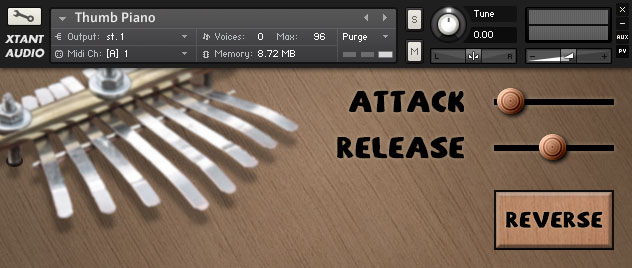The Thumb Piano is a fun little traditional instrument that’s easy to play and can quickly set the mood in an ethnic or world piece of music. In this library we captured the raw sound of a battered and bruised seven tine instrument.
Main Interface
The Thumb Piano has an incredibly simple to use interface. The two sliders control the instrument’s attack and release (they don’t affect the reversed samples). The attack’s range is 0 to 50ms. The release has a range of 100 to 25kms, it defaults to 1500ms when you ctrl/cmd click the slider. You can automate these controls by right-clicking on them and selecting “Learn MIDI CC# Automation” and then moving a hardware controller (it’s probably best not to use the mod-wheel though, see Wah-wah section below).
To switch between normal or reversed samples just click on the “REVERSE” button.
Keyboard Layout

The keys that have the original (as recorded) samples mapped to them are highlighted in green on Kontakt’s on-screen keyboard. So if you want to play the instrument using only the actual real life notes that we recorded then stick to the green keys. The blue keys show where we’ve pitch shifted the samples to fill out the playing range of the instrument.
Keys C2-D2 have percussive tap samples mapped to them, for these we sampled 13 velocity layers.
Keys A2 – B3 are the musical notes of the instrument. These have 7 velocity layers.
Wah-wah
Many Thumb Piano type instruments have a sound hole in their resonator box. Plucking one of the tines and then covering/uncovering this hole results in a wah-wah sound. We’ve added this feature in our virtual Thumb Piano; it’s controlled live using the mod-wheel (CC#1). Raising the mod-wheel covers the sound hole and lowering it uncovers it. As with the real instrument this feature is most noticeable when playing the lower pitched tines/notes.
Acknowledgements
Produced by: David Healey
Recording Technician: Sarah McNeill
Sample Editing & Scripting: David Healey

